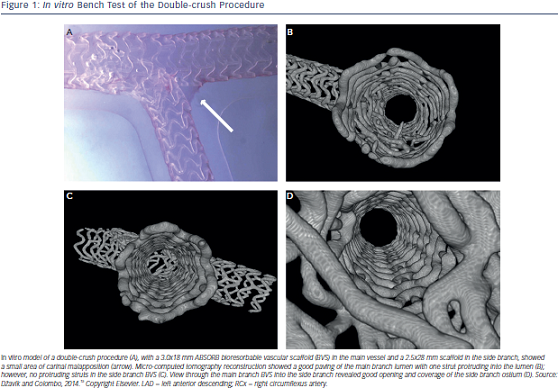In vitro evaluation
D┼¥avík and Colombo recently reported several bifurcation bench tests in which the ABSORB BVS is evaluated in a synthetic arterial model.15 Bifurcation stenting techniques tested included provisional stenting with final kissing balloon inflation (FKBI), modified T-stenting with a FKBI, double or two-step crush technique, mini-crush technique and culotte technique. The investigators used non-compliant (NC) balloons only, to prevent overexpansion of the scaffold due to increased balloon diameters. All procedures were assessed visually and by scanning electron microscopy (single scaffold techniques) and by microcomputed tomography (two scaffold techniques).
The investigators did not see any malapposition or strut fractures after FKBI in provisional stenting of a 3.0x18 mm BVS. FKBI in the provisional stenting technique was performed with a 2.5x20 mm balloon in the SB and 3.0x20 mm balloon in the main branch, both inflated at 8 atmospheres. Strut fractures were observed when FKBI was performed after T-stenting technique using a 3.0x18 mm BVS in the main branch (MB) and a 2.5x18 mm BVS in the SB and 3.0x20 mm (MB) and 2.5x20 mm (SB) balloons inflated at 10 atmospheres. The double- and mini-crush techniques both resulted in mild protrusions of BVS struts in the main branch. Even so, the double-crush technique showed a small area of malapposition between the carina and the two overlying scaffolds (see Figure 1). Likewise, a small area of malapposition was seen if the culotte technique was used, this technique also led to a thick circumferential two-layer scaffold wall in the proximal segment of the MB as well as a bulky BVS neocarina.
in the provisional stenting technique was performed with a 2.5x20 mm balloon in the SB and 3.0x20 mm balloon in the main branch, both inflated at 8 atmospheres. Strut fractures were observed when FKBI was performed after T-stenting technique using a 3.0x18 mm BVS in the main branch (MB) and a 2.5x18 mm BVS in the SB and 3.0x20 mm (MB) and 2.5x20 mm (SB) balloons inflated at 10 atmospheres. The double- and mini-crush techniques both resulted in mild protrusions of BVS struts in the main branch. Even so, the double-crush technique showed a small area of malapposition between the carina and the two overlying scaffolds (see Figure 1). Likewise, a small area of malapposition was seen if the culotte technique was used, this technique also led to a thick circumferential two-layer scaffold wall in the proximal segment of the MB as well as a bulky BVS neocarina.
Based on their observations, the authors recommended to use provisional stenting in the majority of cases, with sequential noncompliant balloon inflation in the SB and the MB and reserving FKBI only if absolutely necessary. Restricted use of planned two-stent techniques, like crush or culotte, was recommended as more bench testing is needed to evaluate the feasibility of these techniques. These recommendations are supported by other bench test studies, performed by White et al. presented at Transcatheter Cardiovascular Therapeutics (TCT) 2013.16